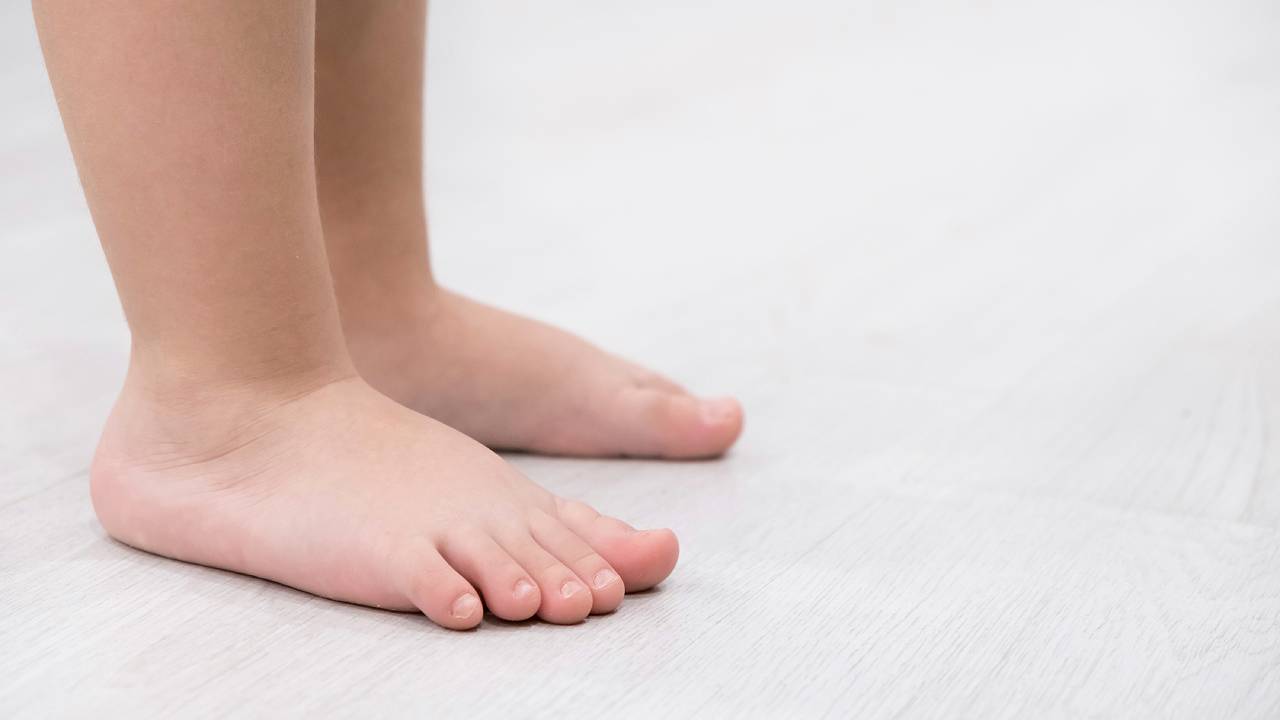There are two types of flat feet:
- Congenital: Present at birth
- Acquired: Can occur to all arch types at any age
At birth, all children should have relatively flat, soft, and chubby feet before the development and appearance of arches around the age of 2 – 3. Congenital flatfoot is a cause for concern as it can signify an underlying vertical talus or atypical joint fusion. It is advised that parents have their child assessed by a specialist in paediatric podiatry as soon as possible if they have concerns or notice any signs and symptoms of paediatric flat foot such as:
- Complaints about leg and foot pain during activities, prolonged periods of walking, or at night
- Requests for massages to relieve aches and pains
- Inability to participate in, or avoidance of, typical play and activities
- Worn out footwear
- Instability and falling over regularly
- Alignment concerns such as an asymmetrical posture
Cases of paediatric flat foot that present with pain should not be taken lightly as they can lead to severe problems later in life. A flattening of only one foot can sometimes be a sign of underlying lower limb abnormalities such as leg length difference, angular torsion, or scoliosis.
Children’s biomechanics should be thoroughly assessed when flatfoot is suspected. Detailed consultation of the child’s status and development from birth will be made together with serial x-rays, images, or scans of the arch profile. This provides an accurate understanding of the structure, causes, and types of intervention that is needed for the child. Podiatric care for flat foot must start promptly after a diagnosis is obtained to reduce the chances of long-term foot and ankle deformities and disabilities.

How is congenital flat foot addressed?
- Serial casting shortly after birth to realign the placement of the foot
- Customised foot orthotics and paediatric ankle foot orthotics with dedicated follow-up sessions to ensure the feet are developing optimally
- In-clinic podiatric care with advanced technologies for reducing muscle tightness in the lower limbs
- Regular focused exercises and at-home instructions to strengthen soft tissue development
Since the foot type and needs of each individual are different, the insertion of generic insoles or a simple change of footwear will do little to address underlying issues. Custom orthotics are specially designed to help with flat feet in children as it accurately guide the development of paediatric feet based on the child’s requirements.
When it comes to paediatric cases, timing is key since bones in the feet develop continuously are ossify at different ages. Once they ossify, bone alignment becomes harder to mould or change. Prompt intervention through close monitoring and timely adjustments is key to the management and resolution of many lower limb alignment concerns.
Frequently Asked Questions
Children’s foot arches typically show around 2 – 3 years of age. If you suspect your child has congenital flat feet, schedule a consultation with one of our podiatrists for a full evaluation as soon as possible.
Your child will not have an arch while standing, and the middle portion of their foot may bulge inwards and show signs of collapse. Their big toe joint may also begin to drift closer to the lesser toes, causing a larger bulge at the big toe joint. This is a noticeable sign of early juvenile bunion formation.
If diagnosed and managed early, flat feet can be corrected. The bones and joints of your child are still malleable at 2 or 3 years old, and prompt realignment will ensure that their feet develop in a corrected position.
This depends on the cause and if it is causing any pain. A paediatric podiatrist should be consulted promptly upon the appearance of symptoms such as:
- Complaints about leg and foot pain during activities, prolonged periods of walking, or at night
- Requests for massages to relieve aches and pains
- Inability to participate in, or avoidance of, typical play and activities
- Worn out footwear
- Instability and falling over regularly
- Alignment concerns such as an asymmetrical posture
Congenital flat foot due to malaligned feet can lead to other conditions such as bunions and hammertoes, or knee and back pain in the future.
Exercises will not correct flat feet. While they can help strengthen muscles, they must be used in conjunction with an appropriate orthotic or custom-made device so your young child is supported during motion.
Problematic flat feet should be addressed as soon as it is diagnosed. The earlier flat feet is attended to, the easier the feet can be moulded and prevented from developing into a rigid deformity that requires surgery.




